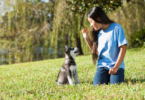Have you ever wondered why some dogs seem to understand commands instantly while others struggle? The secret lies in expert dog training methods backed by science and real-life experiences. Positive reinforcement, a technique endorsed by organizations like the Humane Society and RSPCA, is at the heart of effective training. By focusing on rewarding desired behaviors, you can strengthen your bond with your pet and improve their overall well-being.
Consistency and patience are key. Dogs thrive on clear rules and routines. Whether teaching your dog to “sit” or walk calmly on a leash, breaking commands into small, manageable steps ensures success. Professional trainers emphasize the importance of using high-value rewards, like treats, to motivate your pet and reinforce good behavior.
This guide, supported by insights from certified trainers, will walk you through practical strategies. From basic commands to behavior modification, we'll explore methods that work in real life. Our goal is to empower you with knowledge that enhances your dog's quality of life and strengthens your relationship.
Understanding the Fundamentals of Reward-Based Training
Positive reinforcement is a cornerstone of effective dog training. By focusing on rewarding desired behaviors, you create a positive learning environment for your pet. This method strengthens the bond between you and your dog while enhancing their well-being.
Reward-based training works because it aligns with how dogs naturally learn. When your dog performs a desired action, they receive something they value—treats, toys, or praise. This positive association encourages them to repeat the behavior.
Why Reward-Based Methods Succeed
The key to successful training is consistency and immediacy. When rewards are given right after a desired action, your dog can clearly link the behavior to the outcome. This immediate feedback makes learning more efficient.
Identifying Your Dog's Motivators and Interests
Every dog is unique, with different preferences. Some may be motivated by food, while others prefer play or praise. Understanding what drives your dog helps tailor rewards for effective learning. This personalized approach ensures training is both enjoyable and successful.
Creating an Ideal Training Environment
Setting up the right environment is crucial for effective learning. A calm, distraction-free space helps your pet focus and absorb new information more effectively.
Minimizing Distractions in Your Home
Start by identifying a quiet area in your home with minimal noise and few visual distractions. This could be a corner in your living room or a section of your backyard. Ensure the space is free from competing stimuli like loud noises or other pets.
Use positive reinforcement to encourage your dog to focus. Reward calm behavior with treats or praise, helping them associate the environment with positive experiences.
Establishing a Consistent Training Routine
Consistency is key to successful training. Set a regular schedule with short, frequent sessions that match your dog's attention span. This approach prevents overwhelm and keeps your pet engaged.
Begin in a distraction-free zone to build a strong foundation. As your dog becomes more confident, gradually introduce controlled distractions to help them generalize their learning. This phased approach ensures they can perform commands in various settings.
A well-structured environment lays the groundwork for lasting behavior change. By minimizing distractions and maintaining a consistent routine, you create a positive space where your dog can thrive and learn effectively.
Step-by-Step Command Techniques and Methods
Mastering essential commands is key to effective communication with your pet. Whether it's teaching your dog to “sit” or ensuring they respond to “come,” these techniques build a strong foundation for understanding and trust.
Teaching Basic Commands like Sit and Stay
Start with simple commands like “sit.” Hold a treat above your dog's head and move it backward towards their tail. As they sit, say “sit” and reward them. Repeat until they learn the association.
Once “sit” is mastered, move on to “stay.” Have your dog sit, take a few steps back, and say “stay.” Gradually increase the distance and time. Reward them for remaining in place.
Mastering the ‘Come' Command and Leash Walking
The “come” command is vital for off-leash safety. In an open area, call your dog by name followed by “come” while running backward. Reward them immediately upon arrival. Consistency is crucial.
For leash walking, use a collar and leash. Start in a quiet area, rewarding calm behavior. Introduce distractions slowly, ensuring your dog remains focused. Positive reinforcement keeps them engaged.
Using Fetch and Play to Reinforce Learning
Incorporate play like fetch to make training enjoyable. Use a favorite toy and encourage retrieval. When your dog brings it back, reward and praise them, reinforcing the “come” command.
Short, frequent sessions prevent overwhelm. End on a positive note while they're engaged to maintain enthusiasm and motivation.
Comprehensive Dog Training Advice: Expert Tips for Owners
Effective communication is the backbone of successful dog training. By understanding how your pet learns, you can tailor your methods to their unique needs and preferences. Certified trainers emphasize the importance of clear cues and consistent reactions to ensure your dog stays engaged and motivated.
Integrating Positive Reinforcement Effectively
Mixing treats, verbal praise, and play keeps your pet engaged. For instance, use a treat for the “sit” command, then switch to praise for “stay.” This variety maintains their interest and prevents boredom.
Varying rewards and using intermittent reinforcement can boost motivation. Instead of treating every “sit,” occasionally surprise your dog with a treat. This unpredictability keeps them focused and eager to learn.
Timing and Consistency in Rewards
Timing is crucial. Reward your dog immediately after they perform the desired action. For example, the moment they sit, offer a treat and verbal praise. This immediate feedback helps them link the behavior to the reward.
As your dog progresses, shift from treats to praise. Once they reliably perform “sit,” use praise as the primary reward. Reserve treats for more challenging commands or difficult situations.
Monitoring and Adjusting Methods
Pay attention to your dog's responses. If they seem disinterested, try a different reward. If they're overly excited, calm them with a simpler task. Adjusting your approach ensures their needs are met.
Clear communication is key. Use a unique cue for each behavior and ensure everyone in the household uses the same cues. Consistency avoids confusion and speeds up learning.
Patience and consistency are vital. Every dog learns at their own pace. Celebrate small victories and stay committed to your training routine. With time and effort, you'll see lasting results.
Positive Reinforcement and Behavior Modification Strategies
Understanding and addressing behavioral challenges is a crucial part of fostering a well-behaved and happy pet. Professional trainers emphasize that many common issues, such as excessive barking or pulling on the leash, can be effectively managed through a combination of positive reinforcement and minor corrective cues.
Addressing Common Behavioral Issues
Excessive barking and leash pulling are frequent concerns for many pet owners. To tackle these, start by identifying the root cause. For barking, it could be boredom or anxiety. Redirect their attention with a command like “quiet” and reward calmness. For leash pulling, use a harness and stop walking when they pull, rewarding them when they walk beside you.
Implementing Clear Communication and Consistency
Clear commands and consistent signals are vital. Use a specific word for each action and ensure everyone in the household follows the same cues. For example, “heel” for walking calmly. Avoid harsh corrections, as they can confuse your pet and harm your relationship. Patience is key—celebrate small victories and stay committed to your routine.
Effective behavior modification builds trust and strengthens your bond over time. With consistent, respectful communication, you can help your pet overcome challenges and thrive.
Wrapping Up Your Training Journey
Your journey in dog training is a continuous path of learning and growth. By focusing on reward-based methods, creating a structured environment, and maintaining clear communication, you've built a strong foundation for your pet's development. Remember, consistency and patience are your greatest allies in fostering good behavior and a deep bond with your pet.
Reflect on the progress you've made, whether it's teaching your pet to “sit” or addressing behavioral challenges like barking. Celebrate these milestones and continue exploring new commands and strategies. Positive reinforcement remains a powerful tool, so keep using treats, praise, and play to motivate your pet.
As you move forward, integrate these techniques into your daily routine. Short, engaging sessions and consistent rewards will keep your pet focused and eager to learn. If you encounter issues, don't hesitate to seek professional guidance or additional resources to support your efforts.
With time and dedication, you'll see lasting results that enhance both your life and your pet's well-being. Keep nurturing your relationship through clear communication and positive reinforcement, and remember that every small step brings you closer to your training goals.











Leave a Comment